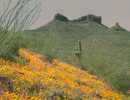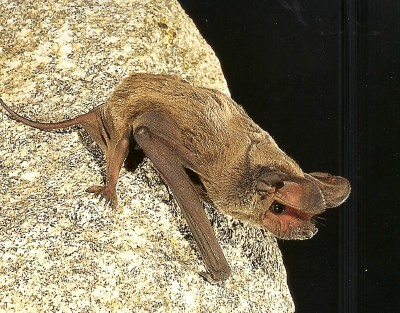
Cabeza Prieta Natural History Association
Sonoran Desert Mammals

Pocketed free-tailed bat
(Nyctinomops femorosacca)

|
Diet: moths, others include beetles, flying ants, flies, leafhoppers, crickets, stinkbugs, lacewings and grasshoppers
Size: weight 10-14 grams (0.4-0.5 ounce) wingspan 34-37 centimeters (13-15 inches) Active Period: nocturnal |
The common and scientific names of the pocketed free-tail bat refer to a shallow fold of skin on the underside of the interfemoral membrane near the knee, which forms a pocket-like structure. It occurs in the arid lowlands of the desert Southwest, and primarily roosts in crevices in rugged cliffs, slopes, and tall rocky outcrops. Colonies are small, usually less than 100 individuals. One baby is born in late June or July.
In day roosts, these bats squeak or chatter much of the time and usually leave the roost well after dark. When first taking flight, they produce shrill, sharp, high-pitched chattering calls, which may continue while the bats are in flight.
As with other free-tailed bats, the flight is swift and lacks the fluttering characteristic of many other bats. At water sources, they fly swiftly about, making distinctly audible whistling and fluttering sounds with their wings. In drinking, these bats will hit the water hard while in flight and scoop up a mouthful of water.
This species is uncommon in the United States.
This article is from "Bats of the United States", 1999, by Michael J. Harvey of Tennessee Technological University, J. Scott Altenbach of the University of New Mexico, and Troy L. Best of Auburn University. Published by the Arkansas Game & Fish Commission, in cooperation with the Asheville Field Office of the U.S. Fish and Wildlife Service.
Photo Credit:
Photo #1
Copyright Creative Commons
HTML & Programing by
Thomas R. Powell